
Guests
- Linn Washingtonaward-winning journalist and former columnist for The Philadelphia Tribune who has covered MOVE since 1975. He teaches journalism at Temple University.
- Mumia Abu-Jamalimprisoned journalist held at SCI Mahoney. He reported extensively on MOVE before he was convicted of killing a police officer, a crime he maintains he did not commit.
Today marks the 30th anniversary of a massive police operation in Philadelphia that culminated in the helicopter bombing of the headquarters of a radical group known as MOVE. The fire from the attack incinerated six adults and five children, and destroyed 65 homes. Despite two grand jury investigations and a commission finding that top officials were grossly negligent, no one from city government was criminally charged. MOVE was a Philadelphia-based radical movement dedicated to black liberation and a back-to-nature lifestyle. It was founded by John Africa, and all its members took on the surname Africa. We are joined in Philadelphia by Linn Washington, an award-winning journalist, professor and former columnist for The Philadelphia Tribune who has covered MOVE since 1975.
Transcript
JUAN GONZÁLEZ: Today marks the 30th anniversary of a massive police operation in Philadelphia that culminated in the helicopter bombing of the headquarters of a radical group known as MOVE. The fire from the attack incinerated six adults and five children, and destroyed 65 homes. Despite two grand jury investigations and a commission finding that top officials were grossly negligent, no one from city government was criminally charged. Here is how the bombing was initially reported in Philadelphia on WCAU [TV].
WCAU ANCHOR: I’ve just been advised that we have new videotape of the episode that apparently ended—we think ended—the MOVE situation tonight: the dropping of an incendiary device. And let’s take a careful look at this. 5:27 p.m., state police helicopter drops it. There is the explosion. As you can see, a very dramatic explosion that occurs 30 seconds and really rips into the MOVE compound. There you see the bunker, which soon will go up in flames. And that was the explosion close-up. Now, if there’s anybody there standing there, it’s obvious they couldn’t survive that explosion.
JUAN GONZÁLEZ: That was WCAU TV, actually. We saw some video there. MOVE was a Philadelphia-based radical movement dedicated to black liberation and a back-to-nature lifestyle. It was founded by John Africa, and all its members took on the surname Africa. In 2010, Ramona Africa, the sole adult survivor of the attack, told Democracy Now! what happened as the bomb was dropped on her house.
RAMONA AFRICA: In terms of the bombing, after being attacked the way we were, first with four deluge hoses by the fire department and then tons of tear gas, and then being shot at—the police admit to shooting over 10,000 rounds of bullets at us in the first 90 minutes—there was a lull. You know, it was quiet for a little bit. And then, without any warning at all, two members of the Philadelphia Police Department’s bomb squad got in a Pennsylvania state police helicopter and flew over our home and dropped a satchel containing C4, a powerful military explosive that no municipal police department has. They had to get it from the federal government, from the FBI. And without any announcement or warning or anything, they dropped that bomb on the roof of our home.
AMY GOODMAN: That was Ramona Africa, the sole adult survivor of the attack on MOVE 30 years ago today. Today, a memorial will take place at the site of the bombing on Osage Avenue.
Well, for more, we’re joined in Philadelphia by Linn Washington, award-winning journalist, former columnist for The Philadelphia Tribune who has covered MOVE since 1975. He teaches journalism at Temple University. Both he and Juan were there that day covering MOVE, the MOVE bombing, for the Philadelphia Daily News.
We welcome you back to Democracy Now!, Linn. Talk about that day, and Juan, too, your memories.
LINN WASHINGTON: Good morning, Amy. Good morning, Juan. The one word that I would use to describe that day is “surreal,” to have witnessed a police firing 10,000 bullets within a 90-minute period—the bullets were so intense that they were raining from the sky like hail—and then, later in the afternoon, to see a bomb dropped on a house occupied by children. And then the very callous decision of the authorities to let the fire burn was just unreal. It’s a sight and a memory that I can’t get out of my mind.
JUAN GONZÁLEZ: Well, Linn, I remember it was on Mother’s Day, 1985, and we were out there most of the day and saw that helicopter suddenly hover over the house and drop something. And I remember saying to you at the time, “What’s going on?” until the explosion occurred. But the most fascinating thing, as you said, and most people are not aware, is how long before—after the bomb dropped before the firefighters even attempted to douse the flames that erupted.
LINN WASHINGTON: It was almost an hour, because we were sitting there on Cobbs Creek Parkway, and you and I were both talking, and actually talking to some of the firefighters as to why they weren’t doing it, and the firefighters didn’t know. What they didn’t—what they were told was to not fight the fire, which is unbelievable. And we could watch—or, actually, we saw the fire go from what looked like the beginning of a backyard barbecue grill fire to a blazing inferno. And we just literally watched it jump across the rooflines and also across the street. So by the time that the decision was finally made to fight the fire, it was a blazing inferno, and it was totally out of control.
AMY GOODMAN: And talk about who was in government, Juan, at the time. Who was the police commissioner? Who was the mayor? How did this bombing take place? The police bombed not just the MOVE house; it ended up burning down two blocks, city blocks, in Philadelphia.
JUAN GONZÁLEZ: Well, yeah, since the—because they didn’t fight the fire, and it spread and destroyed the entire, you know, square block area. But, obviously, the mayor at the time, Linn, was Wilson Goode, the first African-American mayor of the city, and the commission report later indicated that Goode really wasn’t in control of the situation, was he? It was the police commissioner and the fire commissioner.
AMY GOODMAN: So, it was Rizzo entirely?
JUAN GONZÁLEZ: No, it wasn’t Rizzo. It was the—who was the police commissioner? It’s been so long ago, I’ve forgotten.
LINN WASHINGTON: The police commissioner at the—yes, I’m sorry, the police commissioner at the time was a guy named Gregore Sambor. And he—Mayor Goode appointed him because they were trying to purge the department, in some way, of the influence of Frank Rizzo, who had been the police commissioner and then the mayor during the '70s, when police brutality reached epidemic levels in Philadelphia. One of the things that gets lost in all of this is that, yes, there was this horrific bombing in the middle of May, May 13th, the day after Mother's Day in 1985, but weeks—actually, a few days before the bombing, Sambor had ordered a anti-drug sweep that ended up arresting hundreds of people who were innocent, had nothing to do with drugs. The city ended up paying hundreds of thousands of dollars to settle that. And two weeks later, there was a dragnet in a Hispanic neighborhood where they were arresting people from six to 65 years old in an investigation involving the death of a police officer. And that death was initially reported as a domestic dispute between a police officer, another police officer and a policewoman who was married to one of the police officers.
AMY GOODMAN: I want to go back to Ramona Africa, the sole adult survivor of the attack, describing what happened after the bomb was dropped on her house.
RAMONA AFRICA: And without any announcement or warning or anything, they dropped that bomb on the roof of our home. Now, at that point, we didn’t know exactly what they had done. We heard the loud explosion. The house kind of shook. But it never entered my mind that they dropped a bomb on us. But the bomb did in fact ignite a fire. And not long after that, it got very, very hot in the house, and the smoke was getting thicker. At first we thought it was tear gas. But as it got thicker, it became clear that this wasn’t tear gas, that this was something else. And then we could hear the trees outside of our house crackling and realized that our home was on fire. And we immediately tried to get our children, our animals, our dogs and cats, and ourselves out of that blazing inferno.
AMY GOODMAN: Ramona Africa, sole adult survivor of the attack. So talk about who died, Linn, how people tried to escape, and what happened.
LINN WASHINGTON: Yes, the—inside the house were, at that point, five children aged seven to 13 years old. They perished, along with six adults. One of the six adults was the founder of the MOVE organization, John Africa. A number of MOVE members tried to escape, and as you’ve indicated, Ramona was the sole surviving adult. There was a child named Birdie Africa, who later became Michael Ward. They were able to escape. When they were coming out, we heard gunfire. And it was later determined that the police fired on the escaping MOVE members, driving some of them back into the house. But in the convoluted logic that many of us have seen over the last year from grand juries in St. Louis County and in New York and in southern Ohio, where the guy was shot in a Wal-Mart, the grand jury, under the control of Philadelphia prosecutors, determined that MOVE members ran back into the house not because police were firing at them, but because they mistakenly believed that police were firing at them and/or they ran back to intentionally commit suicide.
JUAN GONZÁLEZ: And, Linn, what did the—what were the main conclusions of the MOVE Commission that was established subsequent to that tragedy?
LINN WASHINGTON: Well, the MOVE Commission, which was a panel that the—Mayor Goode had set up to investigate it, but had no power to do anything other than make recommendations, found monumental incompetence on the part of all city officials, from the mayor through the managing director to the police director—or, should I say, the police commissioner. One of the findings, though—I think one of the most prominent findings was that the deaths of those children were unjustified homicides, and they recommended a criminal investigation and also charges to be brought. The grand jury determined that they were not unjustified homicides, that the deaths were as a result of this proposed or presumed suicide. And they came to many startling conclusions, one of which was the bomb that was dropped on the children, there was no illegality there because the force of the bomb only applied to the adults in the house, as if the bomb could blow up and the fire could burn, and it wouldn’t impact the children. It was absolutely ridiculous, but it’s the kind of convoluted reasoning we see too often with grand juries involving issues of police abuse.
AMY GOODMAN: I wanted to turn to imprisoned journalist Mumia Abu-Jamal, who’s being held at SCI Mahanoy. He reported extensively on MOVE before he was convicted of killing a police officer, a crime he says he did not commit. Last month, he recorded a new essay for the 30th anniversary of the MOVE bombing from prison.
MUMIA ABU-JAMAL: May 13th at 30, why should we care what happened on May 13th, 1985? I mean, seriously, that was 30 years ago, a long time ago, way back when. Know what I mean? Most people won’t say that, but they think that. Why, indeed? I’ll tell you why. Because what happened then is a harbinger of what’s happening now all across America. I don’t mean bombing people—not yet, that is. I mean the visceral hatreds and violent contempt once held for MOVE is now visited upon average people, not just radicals and revolutionaries like MOVE. In May 1985, police officials justified the vicious attacks on MOVE children by saying they, too, were combatants. In Ferguson, Missouri, as police and National Guard confronted citizens, guess how cops described them in their own files. “Enemies.” Enemy combatants, anyone? Then look at 12-year-old Tamir Rice of Cleveland. Boys, men, girls, women—it doesn’t matter. When many people stood in silence, or worse, in bitter acquiescence, to the bombing, shooting and carnage of May 13, 1985, upon MOVE, they opened the door to the ugliness of today’s police terrorism from coast to coast. There is a direct line from then to now. May 13, 1985, led to the eerie robocop present. If it had been justly and widely condemned then, there would be no now, no Ferguson, no South Carolina, no Los Angeles, no Baltimore. The barbaric police bombing of May 13, 1985, and the whitewash of the murders of 11 MOVE men, women and children opened a door that still has not been closed. We are today living with those consequences. From imprisoned nation, this is Mumia Abu-Jamal.
AMY GOODMAN: Mumia Abu-Jamal recorded that commentary in prison. Last night, a prison nurse called Abu-Jamal’s wife and told her he had been moved to the hospital for a second time this year. His supporters say they’re concerned he had a fever, and open wounds and sores on his leg. That does it for our show on this 30th anniversary of the MOVE bombing. Thanks so much to Linn Washington in Philadelphia.

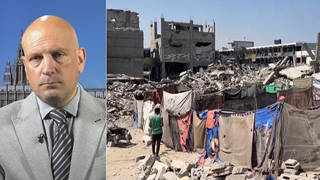
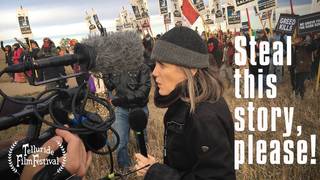
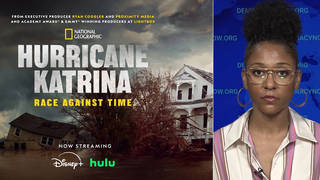

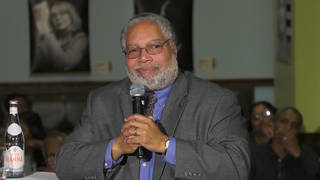

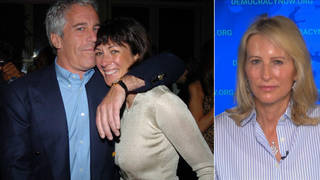
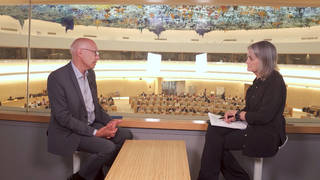

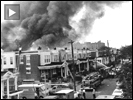
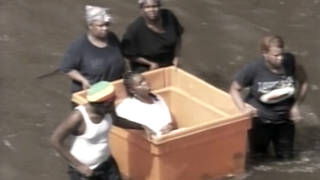
Media Options